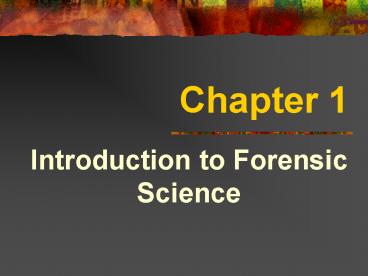Introduction to Forensic Science - PowerPoint PPT Presentation
1 / 41
Title:
Introduction to Forensic Science
Description:
Chapter 1 Introduction to Forensic Science Livor Mortis Blood settles to areas closest to ground Skin turns a blue/purple color Algor Mortis Body starts to lose heat ... – PowerPoint PPT presentation
Number of Views:922
Avg rating:3.0/5.0
Title: Introduction to Forensic Science
1
Chapter 1
- Introduction to Forensic Science
2
Forensic Science
- Application of science to law
- Begins at crime scene
- Also known as Criminalistics
3
History of Forensics
4
Alphonse Bertillon
- Father of Criminal Identification
- Developed ANTHROPOMETRY
5
Anthropometry
- Series of body measurements to distinguish
between individuals
6
(No Transcript)
7
Francis Galton
- Studied fingerprints how to classify them
8
Calvin Goddard
- Firearms examiner
- Studied bullet comparison
- (Done today with a comparison microscope)
9
Edmond Locard
- Started the 1st crime lab (France)
- Developed the Exchange Principle
10
Locards Exchange Principle
- When 2 objects come into contact, there is an
exchange of materials between them - (Cross-transfer of evidence)
- Criminals can be connected to a crime by
particles carried from the crime scene
11
Crime Laboratories
- A. National
- B. State
- C. Local
12
National Labs (4)
- Federal Bureau of Investigation (FBI ?
largest lab in the world) - Drug Enforcement Administration (DEA)
- Bureau of Alcohol, Tobacco, Firearms,
Explosives (ATF) - U.S. Postal Inspection Service
13
State Labs
- Service the state as well as
- local communities that cannot
- afford their own crime lab
14
Local Labs
- Service counties municipal (cities) agencies
- Financed by local government
- Nassau Suffolk County Crime Labs
15
Basic Crime Lab Services
- Physical Science Unit
- Biology Unit
- Firearms Unit
- Document Examination Unit
- Photography Unit
16
Physical Science Unit
- Uses chemistry, physics, and geology to identify
compare evidence
17
Biology Unit
- Examines blood other body fluids
- DNA profiles
- Compares hair fibers
- Examines botanical materials (plants/wood)
18
Firearms Unit (Ballistics)
- Examines firearms, discharged bullets, cartridge
cases, shotgun shells - Searches clothing for gunpowder residue
- Determines distance a weapon was fired from
19
(No Transcript)
20
Document Examination Unit
- Studies handwriting or typewriting
- Analyzes paper ink
- Examines indented writings burned documents
21
(No Transcript)
22
Photography Unit
- Examines records physical evidence
- Only black white photos are shown to jurors
23
Optional Services
- Toxicology Unit ? poisons/drugs
- Latent Fingerprint Unit
- Polygraph Unit ? lie detector
- Voiceprint Analysis Unit
- Evidence Collection Unit ? CSI
24
Evidence the Courts
25
Frye vs. United States (1923)
- Rejected lie detector evidence
- Scientific techniques, procedures, principles
must be GENERALLY ACCEPTED by majority of
scientific community
26
Daubert vs. Merrell Dow Pharmaceuticals (1993)
- GENERAL ACCEPTANCE is no longer absolute
- Trial judge will act as GATEKEEPER ? deciding
whether evidence is admissible or not
27
The Expert Witness
- A person with knowledge that is not expected from
the average individual - This is acquired through experience, training,
education, or a combination of all 3
28
Testimony
- Ordinary witnesses cannot must not give their
opinions ? just FACTS - Expert witnesses can give their opinions based on
scientific facts (but cant be biased to either
side)
29
- Other Areas of Forensic Science
30
Forensic Pathology
- Investigates sudden, unnatural, unexplained, or
violent deaths - Tries to answers Who? What? When? Why? How?
- Via Autopsy
31
Types of Death
- Natural
- Accidental
- Homicide
- Suicide
- Undetermined????
32
Estimating Time of Death
33
Rigor Mortis
- Muscles shorten body stiffens
- Appears within 24 hours
- Disappears within 36 hours
34
Livor Mortis
- Blood settles to areas closest to ground
- Skin turns a blue/purple color
35
Algor Mortis
- Body starts to lose heat
- 1-1.5F per hour until room or outside
temperature is reached
36
Potassium Levels
- Rise in ocular (eye) fluid after death
- Time of death estimated by amount of potassium
present
37
Forensic Anthropology
- Identifies examines human skeletal remains
- Determines race, sex, age, injuries
- Creates facial reconstructions
38
Forensic Entomology
- Studies insects their relation to death
- Blow flies lay eggs ? maggots
39
Forensic Psychiatry
- Determines if people are competent enough to make
decisions or stand trial - Develop behavioral profiles
40
Forensic Odontology
- Studies teeth bite marks
- Useful when a body is unrecognizable
41
Forensic Engineering
- Determines how a crime happened who is
responsible - Accident reconstruction































